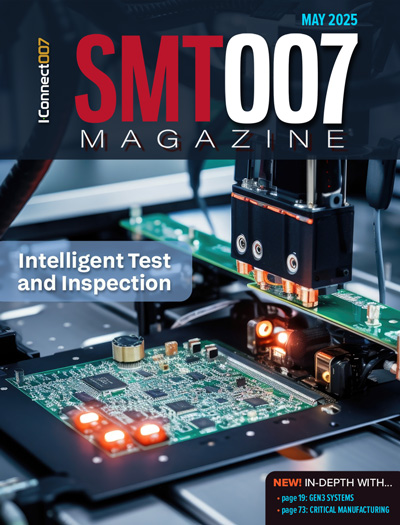-

- News
- Books
Featured Books
- smt007 Magazine
Latest Issues
Current Issue
What's Your Sweet Spot?
Are you in a niche that’s growing or shrinking? Is it time to reassess and refocus? We spotlight companies thriving by redefining or reinforcing their niche. What are their insights?

Moving Forward With Confidence
In this issue, we focus on sales and quoting, workforce training, new IPC leadership in the U.S. and Canada, the effects of tariffs, CFX standards, and much more—all designed to provide perspective as you move through the cloud bank of today's shifting economic market.

Intelligent Test and Inspection
Are you ready to explore the cutting-edge advancements shaping the electronics manufacturing industry? The May 2025 issue of SMT007 Magazine is packed with insights, innovations, and expert perspectives that you won’t want to miss.
- Articles
- Columns
- Links
- Media kit
||| MENU - smt007 Magazine
Applying the New IPC Standard for Traceability Makes Compliance and Reporting Easier
February 8, 2017 | Michael Ford, Mentor GraphicsEstimated reading time: 5 minutes
IPC has created a new standard and specification for traceability practices across all levels of electronics manufacturing, and specifically for electronics assembly. The IPC-1782 standard defines four levels for material and process traceability. With this new standard, companies that are practicing basic levels of traceability can evolve to higher levels (Table 1). Implementing this standard means that companies will be able to clearly define the expectations of what is required for compliance and conformance to customer needs.
Traceability is often a key component of quality standards across the electronics industry. But it has been approached from various points of view, and it can be defined as any combination of material traceability, product tracking, and process recording. And even within material traceability, views can differ on what should be recorded, how detailed it is, and how accurate it needs to be. Materials traceability could mean tracking specific materials to a work order, to a specifically identified PCB within a work order, or even to a specific component placement on that PCB. It may include all types of materials or perhaps only high-value, safety-critical parts or serialized parts. It may include or exclude parts replaced at repair stations or where an alternative or substitute part has been used, and it can include many more examples where a choice in the depth and breadth of recording is needed.
Table 1: IPC-1782 summary of traceability levels.
Accuracy is another area of contention. Process operational efficiency may conflict with the accuracy with which the traceability data is collected, as for example trays are re-filled without positive poka-yoke confirmation of verification. These are just some typical variations in the level and degree of material traceability. For product tracking and process data recording, an immense number of other similar decisions have to be made.
Individual companies typically have created their own set of high-level rules for traceability data that should be collected as part of their conformance requirements. The problem with all of these different specifications, often made without an in-depth understanding of the processes involved, was that exactly what data should be recorded, from where, and how it was supposed to relate to the product and process was left undefined. This has resulted in the collection of traceability data that is unreliable, incomplete, and/or irrelevant.
Negotiations around traceability requirements between the product owner and manufacturing have become increasingly difficult because neither speaks the same language, and they have common no point of view. Spectacular and public cases of product recalls have been the result, even while electronic systems are becoming more of a critical part of our everyday lives, and counterfeiters are having a significant effect on product quality and brand trust.
Compliance to internal or external standards helps assure manufacturers that work is only placed into manufacturing centers which demonstrate the appropriate compliance certificates or approvals. Today, compliance requirements extend to all quality sensitive markets for electronic goods such as military, medical, automotive, aerospace, telecommunications, and industrial controls. Even lower-priced consumer goods, such as handsets, toys, and games, require safety and environmental compliance. Manufacturers who are not able to demonstrate this compliance simply do not win business in these markets. These trends are driving manufacturers to implement higher levels of traceability for a wider range of industry segments.
The IPC-1782 Critical Components Traceability Task Group was created to address these issues. This committee has completed the first all-encompassing traceability standard for electronics, which is designed to be applicable to every product, in every company. Traceability is seen by many as a burden to the manufacturing process, and no one wants to have to comply or conform to yet another process or standard in the office or factory. The IPC-1782 committee members who all contributed so much to the creation of the traceability standard agreed that traceability ought to be implemented based on the merit that it brings to the manufacturing operation, rather than through some compliance mandate.
The nature of electronics assembly is hierarchical. A finished product, represented by an assembly cell, is typically made up of raw materials plus subassemblies. Each of the subassemblies is, in turn, a finished product of another assembly process also made up of raw materials and potentially other subassemblies. Thus, the IPC-1782 task group thought that the structure of traceability data should align with this physical reality. Figure 1 is a simple illustration of this structure.
Figure 1: The hierarchical data structure approach adopted by the IPC-1782 standard.
The assembly cell, here identified as “724435,” contains data about the work order and process sequence, BOM, the process traceability data, which is a record of events and transactions that have taken place during the assembly process, and the materials traceability data which contains information about specific raw materials, as well as other “roots” of information about each subassembly.
Page 1 of 2
Suggested Items
S&K Aerospace Awarded Major Contract Under DLA Maritime Acquisition Advancement Program
07/02/2025 | BUSINESS WIRES&K Aerospace, LLC has been awarded a significant contract under the Defense Logistics Agency’s (DLA) Maritime Acquisition Advancement Program, managed by the U.S. Naval Supply Command - Weapon Systems Support (NAVSUP WSS) in Mechanicsburg, PA.
Green Circuits to Exhibit Full-Service Electronics Manufacturing Solutions at 2025 SMD Symposium
07/02/2025 | Green CircuitsGreen Circuits, a full-service Electronics Manufacturing Services (EMS) partner to leading OEMs, is pleased to announce its participation in the 2025 SMD Symposium, taking place August 5-7 at the Von Braun Center in Huntsville, Alabama.
I-Connect007 Editor’s Choice: Five Must-Reads for the Week
06/27/2025 | Nolan Johnson, I-Connect007While news outside our industry keeps our attention occupied, the big news inside the industry is the rechristening of IPC as the Global Electronics Association. My must-reads begins with Marcy LaRont’s exclusive and informative interview with Dr. John Mitchell, president and CEO of the Global Electronics Association. For designers, have we finally reached the point in time where autorouters will fulfill their potential?
Knocking Down the Bone Pile: Tin Whisker Mitigation in Aerospace Applications, Part 3
06/25/2025 | Nash Bell -- Column: Knocking Down the Bone PileTin whiskers are slender, hair-like metallic growths that can develop on the surface of tin-plated electronic components. Typically measuring a few micrometers in diameter and growing several millimeters in length, they form through an electrochemical process influenced by environmental factors such as temperature variations, mechanical or compressive stress, and the aging of solder alloys.
RTX, the Singapore Economic Development Board Sign MOU Outlining 10-year Growth Roadmap
06/20/2025 | RTXRTX and the Singapore Economic Development Board (EDB) have signed a Memorandum of Understanding (MoU) which outlines a 10-year roadmap to further long-term strategic collaboration in Singapore.


